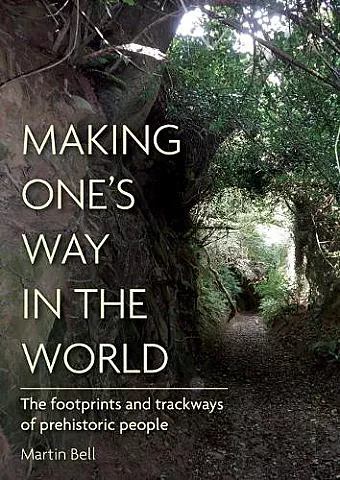Making One's Way in the World
The Footprints and Trackways of Prehistoric People
Format:Hardback
Publisher:Oxbow Books
Published:31st Jan '20
Should be back in stock very soon

The book draws on the evidence of landscape archaeology, palaeoenvironmental studies, ethnohistory and animal tracking to address the neglected topic of how we identify and interpret past patterns of movement in the landscape. It challenges the pessimism of previous generations which regarded prehistoric routes such as hollow ways as generally undatable.
The premise is that archaeologists tend to focus on ‘sites’ while neglecting the patterns of habitual movement that made them part of living landscapes. Evidence of past movement is considered in a multi-scalar way from the individual footprint to the long distance path including the traces created in vegetation by animal and human movement. It is argued that routes may be perpetuated over long timescales creating landscape structures which influence the activities of subsequent generations. In other instances radical changes of axes of communication and landscape structures provide evidence of upheaval and social change. Palaeoenvironmental and ethnohistorical evidence from the American North West coast sets the scene with evidence for the effects of burning, animal movement, faeces deposition and transplantation which can create readable routes along which are favoured resources.
Evidence from European hunter-gatherer sites hints at similar practices of niche construction on a range of spatial scales. On a local scale, footprints help to establish axes of movement, the locations of lost settlements and activity areas. Wood trackways likewise provide evidence of favoured patterns of movement and past settlement location. Among early farming communities alignments of burial mounds, enclosure entrances and other monuments indicate axes of communication. From the middle Bronze Age in Europe there is more clearly defined evidence of trackways flanked by ditches and fields. Landscape scale survey and excavation enables the dating of trackways using spatial relationships with dated features and many examples indicate long-term continuity of routeways. Where fields flank routeways a range of methods, including scientific approaches, provide dates.
Prehistorians have often assumed that Ridgeways provided the main axes of early movement but there is little evidence for their early origins and rather better evidence for early routes crossing topography and providing connections between different environmental zones. The book concludes with a case study of the Weald of South East England which demonstrates that some axes of cross topographic movement used as droveways, and generally...
[…] this important book […] could not be more topical. * British Archaeology *
There is a good deal of novel thought and synthesis in this essentially stall-setting book; a research agenda that will intrigue many. * Northern Earth *
It’s incredibly wide ranging, detailed and thorough. All the things I’d hoped to read about were there in spades along with an entire tranche of evidence and opinions that were new to me and kept me happily turning pages, right to the end. I’d definitely advise this book for anyone with an interest in prehistory. * The Prehistoric Society *
This is an interesting and incredibly readable book examining the physical environmental evidence for the most basic of human needs, subsistence mobility and community interaction. The text is supported by well-chosen illustrations, it is extremely well-referenced and though descriptive in parts, it is critical throughout and delivers much food for thought. * Archaeologia Cambrensis - Cambrian Archaeological Association *
ISBN: 9781789254020
Dimensions: unknown
Weight: unknown
320 pages